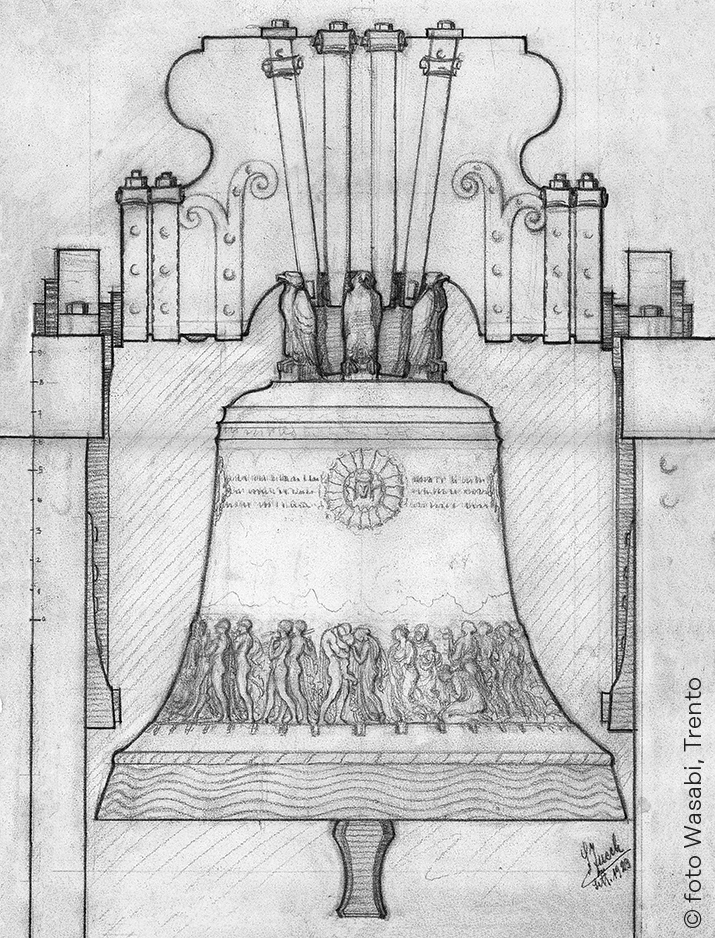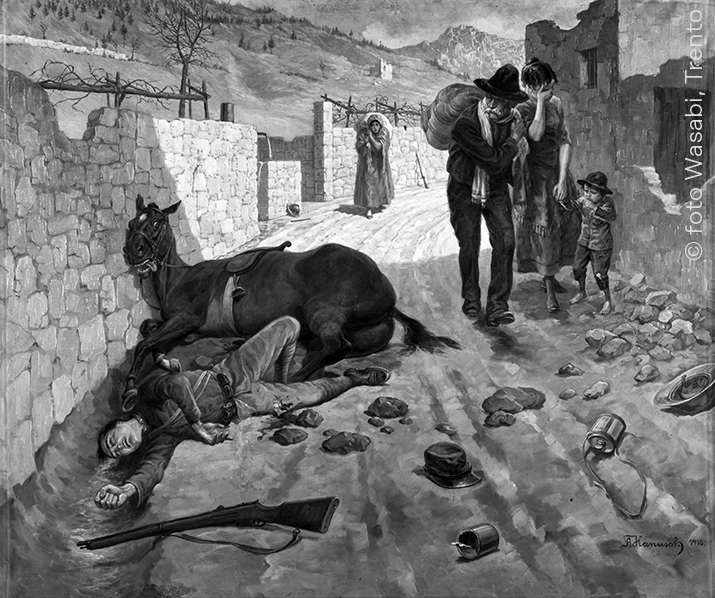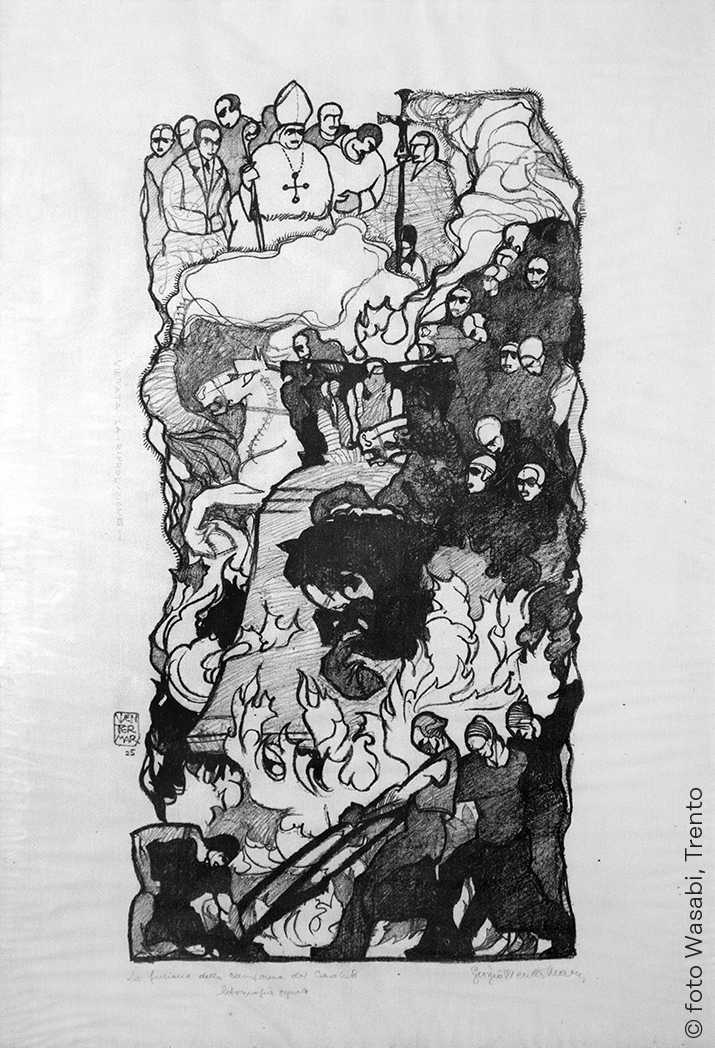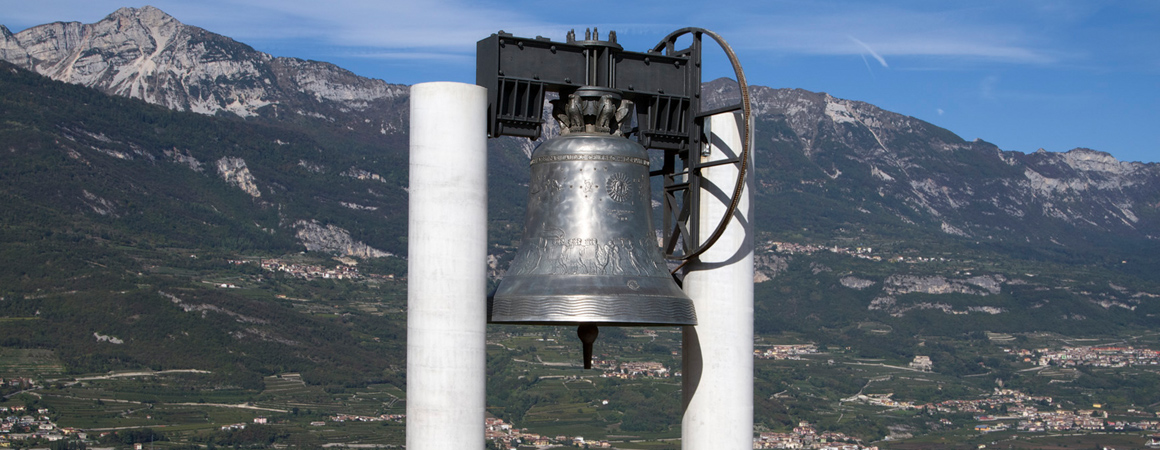AN EXHIBITION FOR THE 100TH ANNIVERSARY OF MARIA DOLENS
To mark the centenary of the first tolling of Maria Dolens, the Campana dei Caduti Foundation proposes an exhibition that will open on 12 April and close on 31 October 2025. We asked the curator, art historian Chiara Moser, to tell us about the criteria on which it is based.
One hundred years after the casting of Maria Dolens, the Campana dei Caduti Fondazione in Rovereto is preparing to celebrate its Bell in 2025. In fact, a century has passed since Don Antonio Rossaro promoted this visionary undertaking, donating this symbol of Peace and rebirth to Rovereto and the Province in primis, but in concrete terms to the whole world.
The exhibition aims to retrace the 'myth' of the Bell. It is not a celebration of the object itself, but a reflection on how Maria Dolens has left its mark on the collective imagination, how it has imprinted itself on the memory of the community, and how the Bell has shaped its time while continuing to make an impact today, thanks to the Foundation that preserves its message.
There will be two main focuses, the first dedicated to 'Artists, souvenirs and mass media'.
During the First World War, modern propaganda was born. The mass media - press, cinema and radio - were used to garner support for the war effort and boost morale. Don Antonio Rossaro, in the aftermath of the conflict, cleverly reinterpreted what he saw in the dark years of the Great War to build a contemporary legend. As Renato Trinco aptly writes, Don Antonio Rossaro created around the Bell of the Fallen an aura of poetry and spirituality, not without the rhetorical emphasis associated with the veneration of those who fell for their homeland.
The prelate thus succeeded in organising a campaign of propaganda and dissemination through the most varied communication channels, primarily the press, without neglecting cinema and radio, placing in particular a strong emphasis on official events. He immediately involved the community of artists, also thanks to the help of Giorgio Wenter Marini, the clergyman's cousin, commissioning the creation of postcards, posters, and medals as well as objects. Indeed, since its first casting, the Bell has entered households and homes through a thriving market of objects and printed materials. From the very beginning, Don Antonio Rossaro encouraged the production of souvenirs and small objects, understanding the importance of allowing 'its' symbol to enter the intimacy of every family.
Don Antonio Rossaro also borrowed inspiring themes, iconography and models from art, and the artists in turn, while the artists, in turn, offered a reinterpreted vision of this legend.
Works from public and private collections would thus narrate the genesis of Maria Dolens, beginning with the context in which Don Antonio Rossaro envisioned it and extending to various representations and interpretations
The second focus is on 'the Foundation and international momentum'.
‘The monumental Bell of the Fallen was placed on Rovereto Castle, which has seen so many cruel battles and which flew over the trenches of Serravalle the white flag of armistice that put an end to the Great War. The bell should remain forever on Rovereto Castle, as a daily commemoration of the historic events and the Dead of the Great War, who fell in combat, each fighting for a noble ideal.’ From the intentions stated in the Magna Charta, the founding act of the Bell, to today, the journey has been long and eventful.
The Foundation's founding act, signed by President of the Republic Giuseppe Saragat on 18 January 1968, is a milestone that opened up previously unimaginable horizons. This made it possible to expand the mission that the founder had already envisioned: to address all of Humanity and to serve as a voice not only for the heroism and tragedies of those who had fallen in war but also for the need to foster exchanges and relationships of Peace among nations.
Over these decades, the Foundation has been actively engaged in promoting cultural and educational initiatives aimed at building a culture of Peace and inclusion. In this section, set up in the Gallery, two crucial moments in this history will be specifically addressed: the partnership with the Council of Europe and the special consultative status with the United Nations.
The aim is not only to showcase the Foundation's activities within these contexts but also to invite visitors to learn about these international organisations—now so "close" through the communication that reaches us daily, yet still so elusive. The aim is to address these issues on a concrete level, close to ordinary people (in the most general and positive sense of the term).
To support this narrative, contemporary artworks from the Foundation's collection will be used to engage, challenge, and provoke visitors, encouraging them to explore pressing contemporary issues addressed by the Council of Europe, the UN, and, by extension, the Campana dei Caduti Foundation.
The aim of the exhibition is to tell the story of the hundred years of the Bell, Maria Dolens which is 'here' but at the same time is 'everywhere', because, as Director Alberto Robol said, quoting Father Eusebio Jori, Don Rossaro’s successor 'The Bell is in Rovereto, but it is not only Rovereto’s'.

Stefano Zuech, 'Design for the Maria Dolens War Memorial Bell' (1923. Rovereto, Fondazione Opera Campana dei Caduti)

Hanusch, 'The evacuation in Vallarsa' (1918, Rovereto, Italian War History Museum)

Giorgio Wenter Marini, 'The Casting of the Bell of the Fallen' (1925, lithograph. Rovereto, Italian War History Museum)






